 Katie Morley
Katie Morley
Jan 19, 2024
 Katie Morley
Katie Morley
Jan 19, 2024
Traditional marketing approaches, with their broad and indiscriminate reach, often struggle to meaningfully connect with customers. The problem isn’t that they don’t work at all — it’s rather that they fail to connect with precision and consistency throughout the entire customer journey.
For example, many companies show ads for products that customers have already purchased. Besides being annoying, this is a huge missed opportunity to nurture the relationship by suggesting products that go well with the ones customers have already bought.
Tons of similar customer targeting approaches cause companies to lower their profit margins, miss out on revenue, and deliver inconsistent customer experiences.
Moreover, we find that many brands also struggle with:
This is where predictive marketing can be a game-changer: by harnessing the power of data analytics, artificial intelligence (AI), and machine learning, predictive analytics offers a strategic solution to many of these issues.
What’s more, predictive marketing enables proactive, rather than reactive, strategies, allowing you to stay ahead of the curve. It also better ensures that every dollar spent is an investment towards reaching the right audience, with the right message, on the right channel.
In this guide, you’ll learn exactly what predictive marketing is and how to use it, along with its advantages and potential uses. We’ll also use Insider — our cross-channel personalization platform — to show real-world examples of predictive marketing’s impact on customer segmentation, product discovery, and journey orchestration.
Insider can help you implement various predictive marketing strategies for better engagement, more conversions, and higher profitability. To learn more, visit our website or schedule a demo with our team.
What is predictive marketing?
6 benefits of predictive marketing
How does predictive marketing work?
Examples of predictive marketing strategies
Predictive marketing in action: 3 real-life case studies
Use Insider’s AI-powered intent engine to accurately predict customer behavior
Predictive marketing is the practice of analyzing customer data to predict future behaviors and preferences. It relies on AI and machine learning and enables businesses to create targeted, relevant, and personalized marketing strategies.
You can think of predictive marketing as actionable insights deriving from predictive intelligence — a technological capability that uses historical data and various statistical algorithms to identify the likelihood of future outcomes.
As we’ll discuss in this guide, predictions can also come in different forms. You can predict which customers are likely to buy, which channel they’re most likely to engage on, what products they’d like to see next, and more.
For example, brands like Amazon, Netflix, and many others analyze massive data sets to create highly targeted predictions and determine what products or content you’d like to see. This is crucial for them, as they have gigantic product catalogs which can easily overwhelm users.
Predictive marketing brings a number of advantages to data-driven marketers seeking to improve their customer experience, revenue, and retention.
As we said, predictive marketing uses past data to understand what existing customers like, want, and need. By analyzing data points like past purchases, browsing behavior, and channel-specific interactions, predictive marketing technologies can accurately guess what might appeal to them in the future.
For customers, this is like walking into a store where everything you see aligns perfectly with your tastes and desires. This level of personalization makes you feel understood and valued while deepening your connection with the brand.
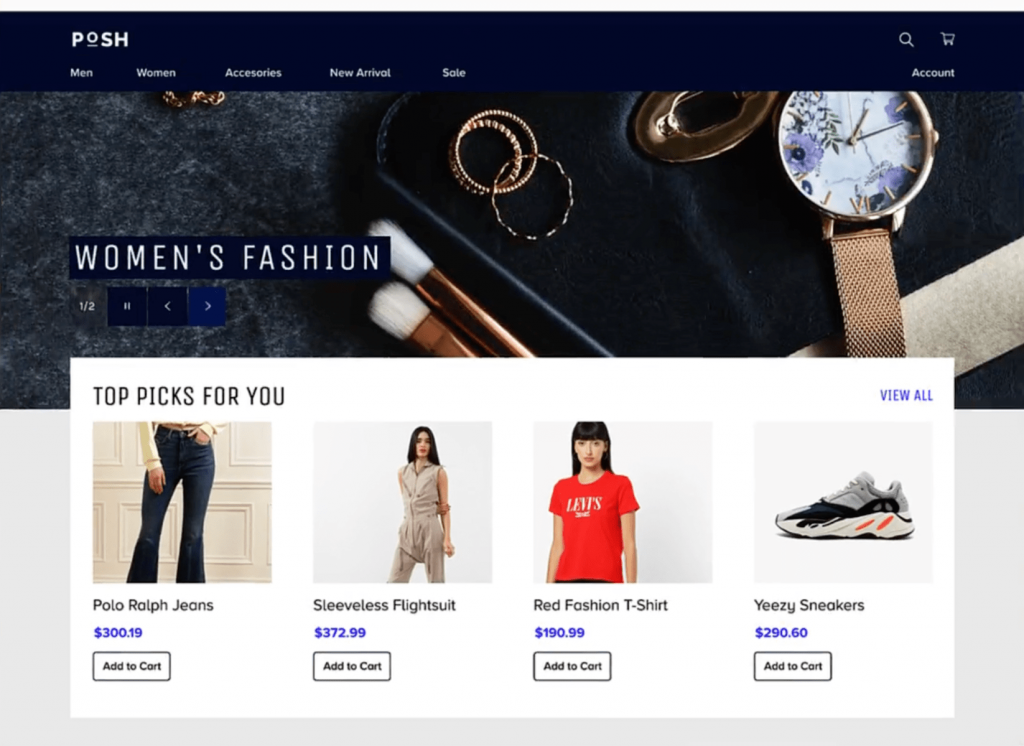
Customer satisfaction often translates into brand loyalty and a greater likelihood to share positive experiences with others, as well as to re-engage with the brand in the future.
Many businesses have a rough idea of their target audience, like “women aged 20-30 in New York,” but this approach is pretty broad and doesn’t consider the unique differences in each customer’s preferences and behaviors.
Predictive marketing helps you take out much of the guesswork here and make truly data-driven decisions.
By dissecting and understanding customer data deeply, predictive algorithms enable businesses to accurately target each customer based not only on classic characteristics like purchase histories, demographics, and locations but also on their likelihood of purchasing, projected spending, discount affinity, and more.
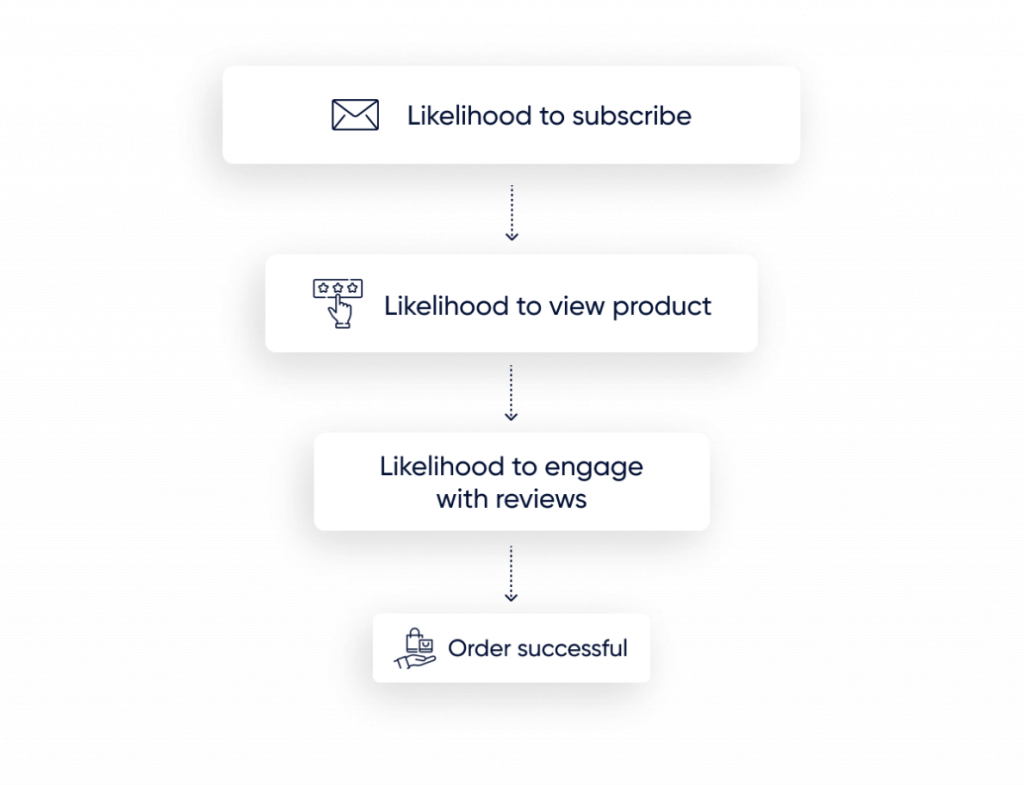
A targeted approach makes customers more likely to buy because they see messaging and product recommendations that actually matter to them.
For instance, if someone frequently browses sports equipment on your website, predictive marketing would suggest showing them ads, website content, or emails about your latest sports gear.
But it’s not just about being relevant. Timing is also key. Predictive marketing helps figure out the best time to reach out to customers. Maybe some customers check their emails first thing in the morning, while others are more likely to shop online late at night. By using data to understand these habits, predictive marketing ensures that your messages land in front of customers at just the right moment.
As mentioned earlier, many eCommerce stores constantly run discounts to get customers to buy. However, this can eat into their profit margins.
Predictive marketing lets you target users with the highest intent (i.e., high likelihood to purchase), so you can promote products at their regular price to these customers, instead of wasting your discounts since they’ll likely buy anyway. On the flip side, predictive segmentation lets you also target customers with a high discount affinity.
Both of these tactics protect your profit margins and help you make smart marketing decisions regarding your discounts.
Predictive marketing enables you to nurture long-term relationships and boost key metrics like revenue, average order value (AOV), and customer lifetime value (LTV).
For example, Insider’s AI-powered Smart Recommender can show different products to each customer, depending on their unique needs and interests. This means you can leverage customers’ past behavioral data to determine what products they’d like to see in the future.
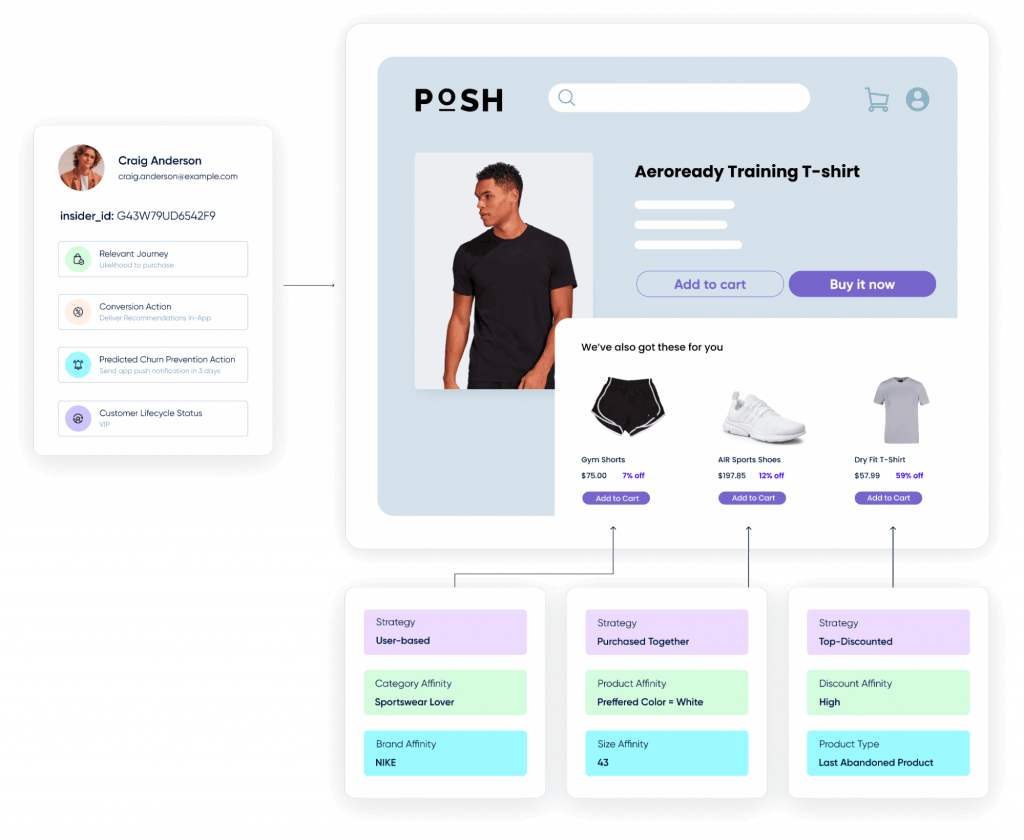
Insider also has an automated recommendation algorithm (called Chef) that can automatically detect the best recommendation strategies by testing the most popular items, top sellers, user-based, highest discounted, new arrivals, and trending items algorithms for better conversion rates.
Traditionally, marketing has often been about reacting — like sending out a coupon after noticing a dip in sales or changing an ad campaign once you realize it’s not hitting the mark.
But predictive marketing flips the script. Instead of waiting for signals and then responding, predictive intelligence uses data and analytics to forecast what customers will want or need in the future. In this way, you’re always one step ahead.
For example, if predictive analytics show that a certain type of product is becoming popular, you can ramp up your marketing before the trend hits its peak. Or, if the data suggests a customer might be losing interest in your brand, you can re-engage them with a personalized offer before they start looking elsewhere.
Accurate data is at the heart of predictive marketing. The more you have of it the better. AI and machine learning tools analyze this data using different algorithms and predictive models to forecast future customer behaviors and preferences.
The process combines data science with marketing know-how to make educated guesses about what customers might do next, whether it’s what they’re likely to buy, when they might make a purchase, or how likely they are to engage on a specific channel.
While many brands have the necessary data to do this, it’s often scattered around disconnected systems — like analytics software, email marketing platforms, loyalty tools, customer service solutions, eCommerce platforms, social media tools, and more. This creates data silos that prevent marketers from getting a clear understanding of their customers and hinders accurate predictions.
That’s why a good customer data platform (CDP) like Insider is so crucial for making accurate predictions. CDPs unify customer data from different sources into one convenient database. This means they can act as a central hub for storing and analyzing customer data.
Plus, our platform’s AI-powered intent engine can analyze this unified data to come up with accurate predictions around each customer’s likelihood to purchase, likelihood to engage on a specific channel, discount affinity, and more.
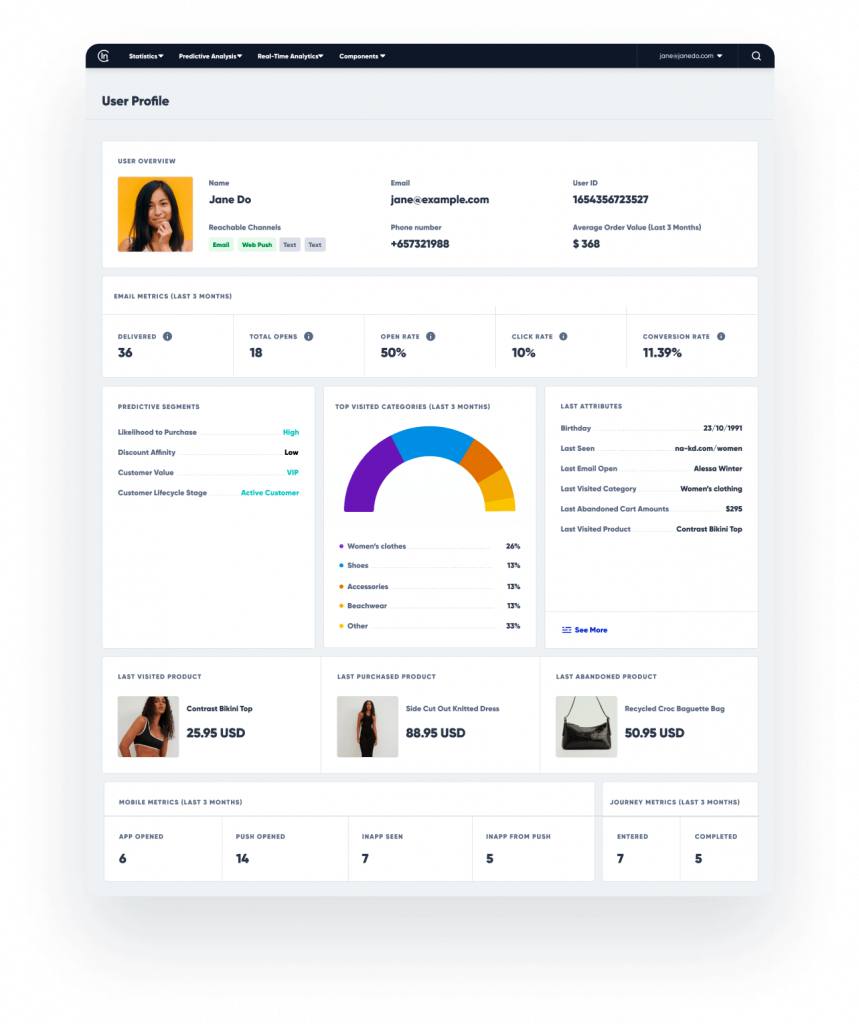
You also get a dedicated predictive marketing analytics dashboard with all sorts of useful stats and metrics, as shown below.
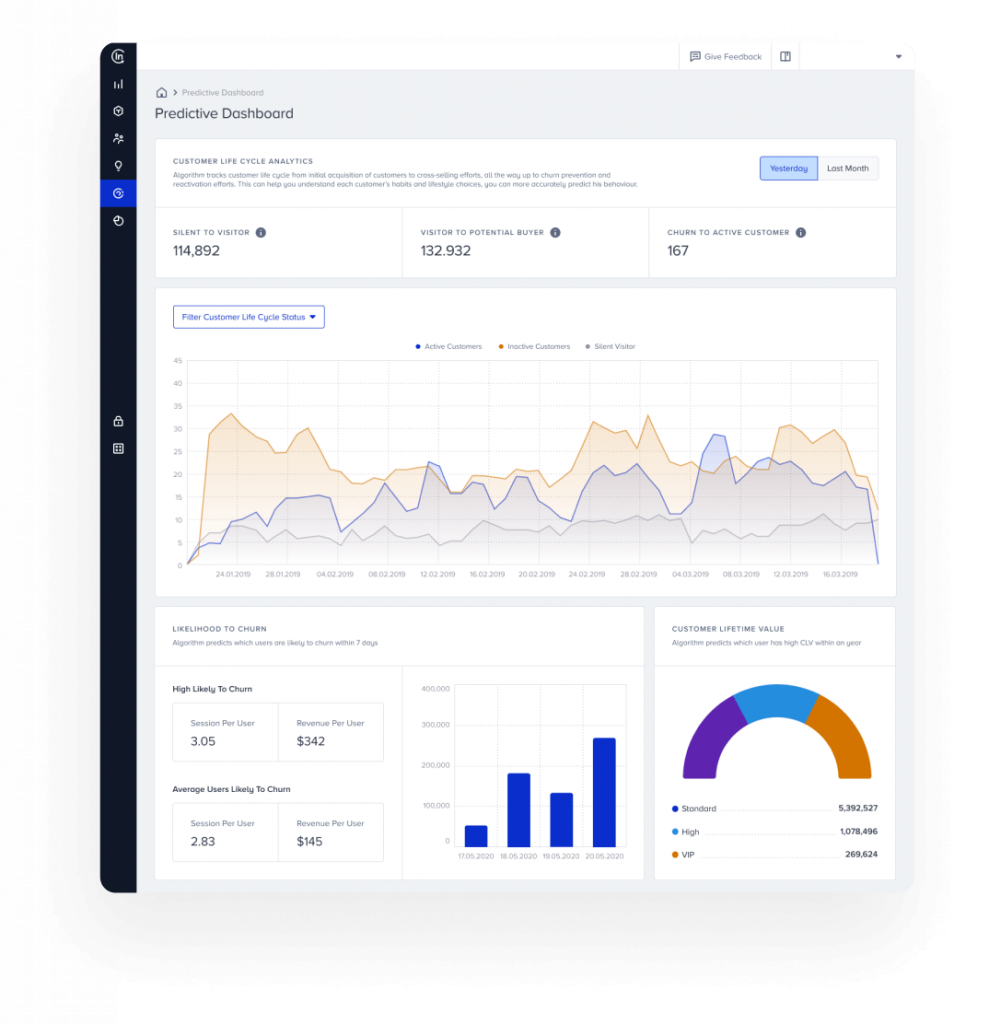
Below, we’ll explore some practical examples of how Insider’s predictive marketing capabilities can impact workflows and key business metrics.
As we mentioned earlier, personalized product recommendations are tailored suggestions for customers based on their unique preferences and past behaviors, such as purchase history and online browsing patterns.
They can have a massive impact on conversions and revenue. For example, Philips used Insider’s AI-powered product recommendations to improve their mobile conversion rates by 40.1% and generate over €20,000 of incremental revenue.
Plus, with Insider, these recommendations aren’t limited to your website. You can extend them to messaging channels like email, SMS, and WhatsApp to ensure a consistent experience across the board.
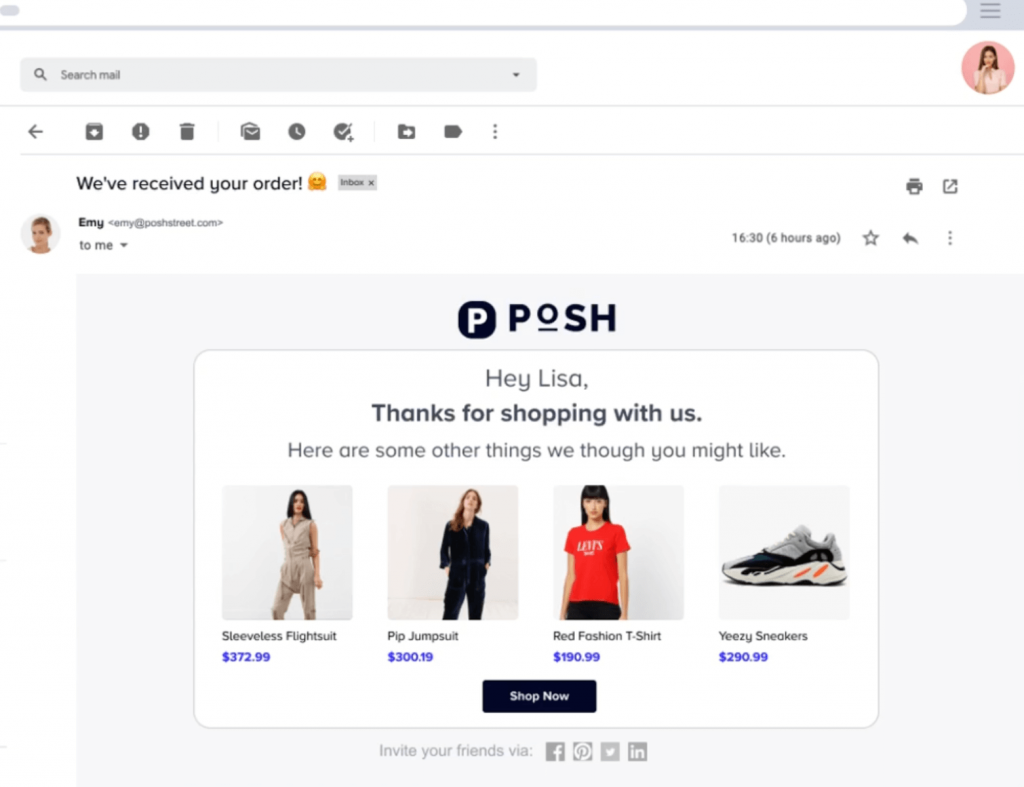
If you’re interested, we explore this topic in more detail in our guide to product recommendation engines.
Insider’s platform offers robust segmentation capabilities, allowing marketing teams to create highly targeted customer segments based on over 120 attributes, including traits, behaviors, preferences, demographics, and more.
Additionally, Insider’s AI-powered predictive engine lets you segment and target customers based on future predictive behaviors, like:
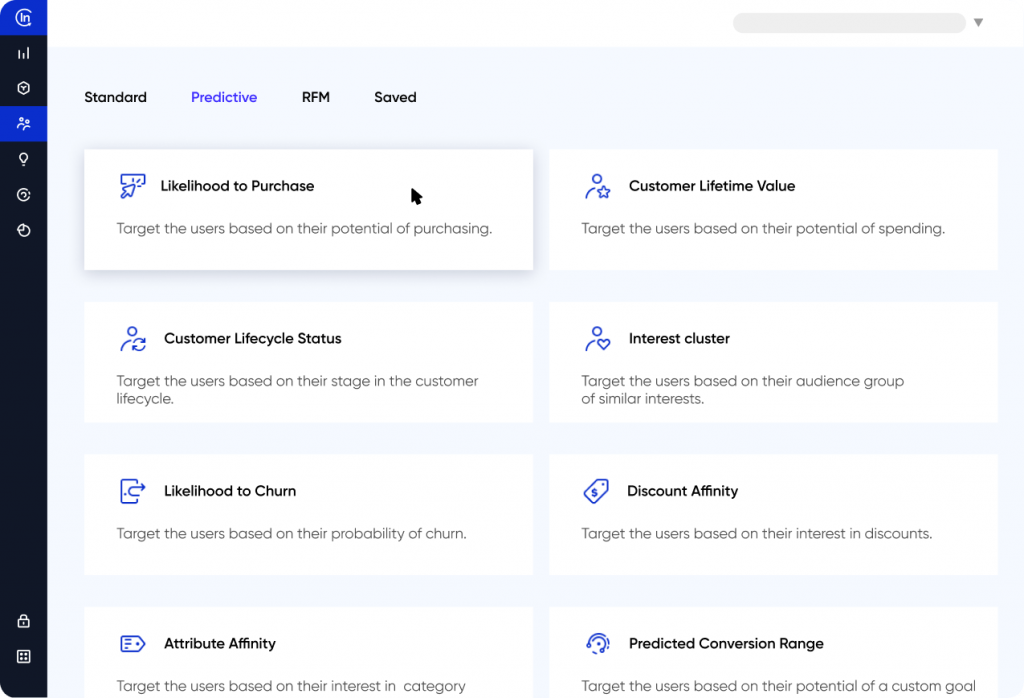
These predictive audiences open up a ton of opportunities for more accurate customer targeting. For example, you can segment users who:
Besides product discovery and segmentation, predictive marketing is also perfect for building relevant and consistent customer journeys.
Specifically, two predictive features can help you deliver each message with pinpoint precision — Next-Best Channel Predictions and Send-Time Optimization (STO).
Next-best channel predictions are about figuring out the best touchpoint to contact each customer. This feature analysis analyzes past behavior and automatically uses the channel each customer is most likely to engage on — whether that’s email, push notifications, SMS, WhatsApp, and so on.
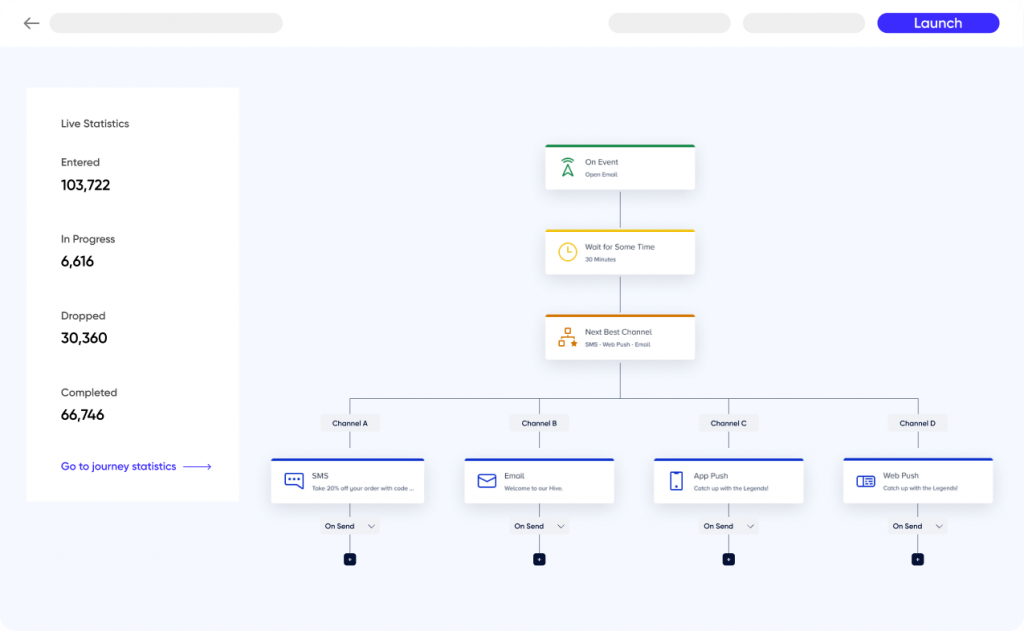
STO analyzes when your customers are most active and responsive on different channels and schedules your messages accordingly. For example, if data shows that a customer often checks emails in the evening, STO will ensure that your email lands in their inbox right around that time. This increases the chances that your message won’t just be seen but also acted upon.
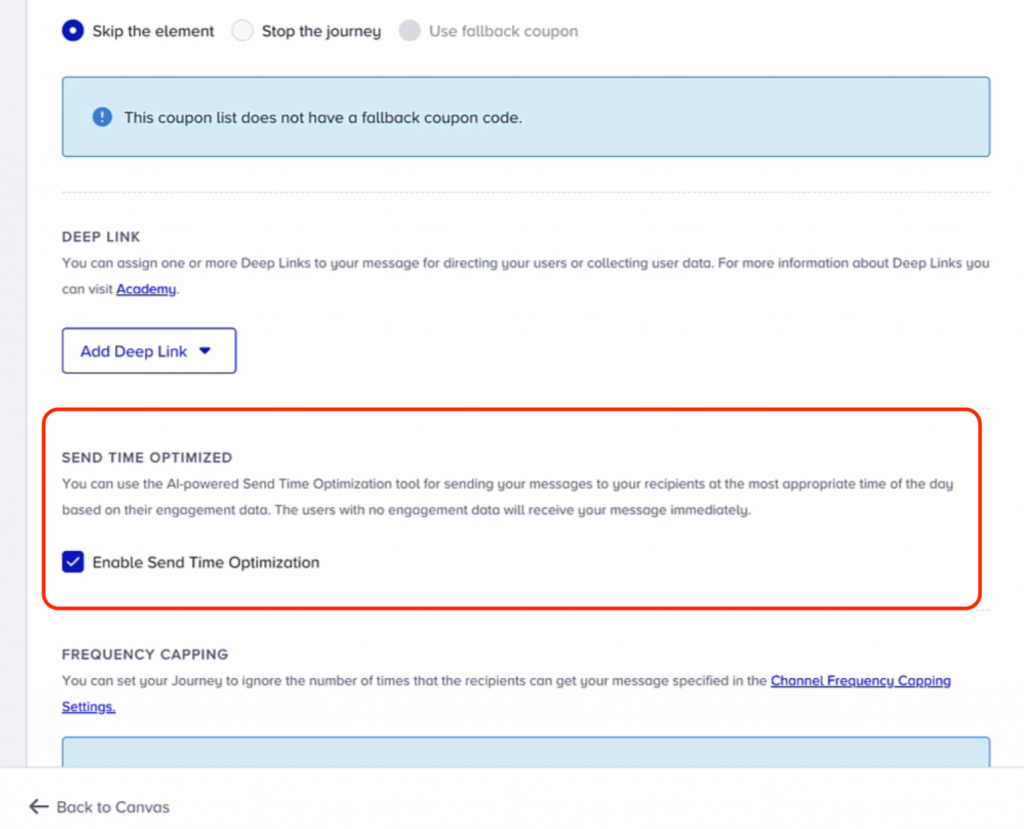
Both of these features ensure that each step of the journey is tailored not just in terms of content, but also through the right channel and at the right time. They also save you tons of time and effort since you don’t have to manually A/B test different channels and send times to determine the best one.
Now that you know how predictive marketing works and where it can be applied, let’s explore a few real-life examples of its power. The three companies below used different types of strategies we just explored — product recommendations, customer journey building, and segmentation.
Facing a surge in online traffic during the COVID-19 lockdowns, Adidas sought to engage and retain visitors more effectively. Specifically, they wanted to better predict what products website visitors would like to see in order to improve conversion rates.
That’s why they turned to Insider’ AI-powered Smart Recommender and Category Optimizer. Within just one month of using these tools Adidas witnessed a staggering 259% increase in Average Order Value (AOV) and a 13% rise in conversion rates.
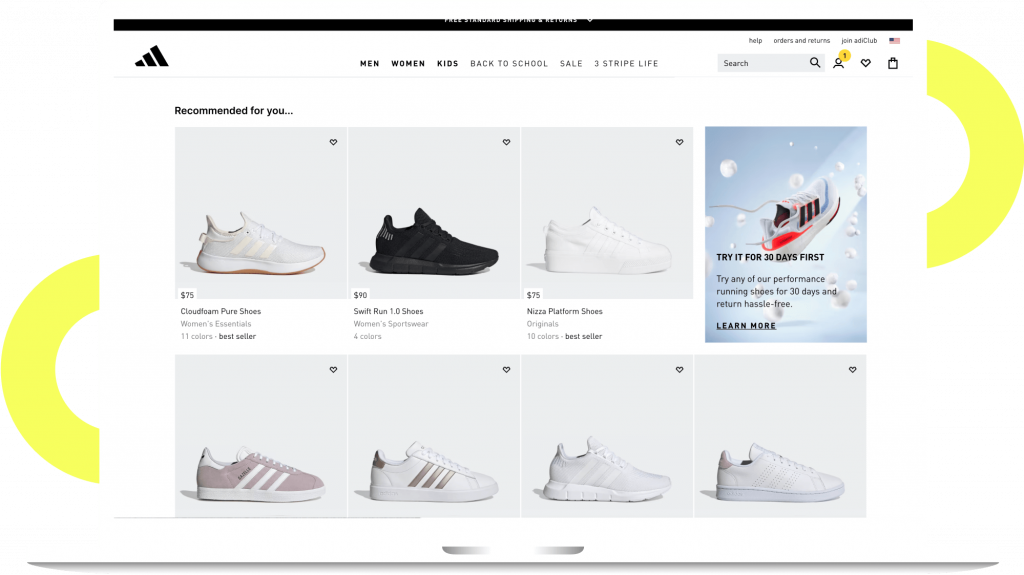
Another key to Adidas’ success were their targeted marketing campaigns and strategic use of personalized coupon codes, which improved the online shopping experience for new and returning customers.
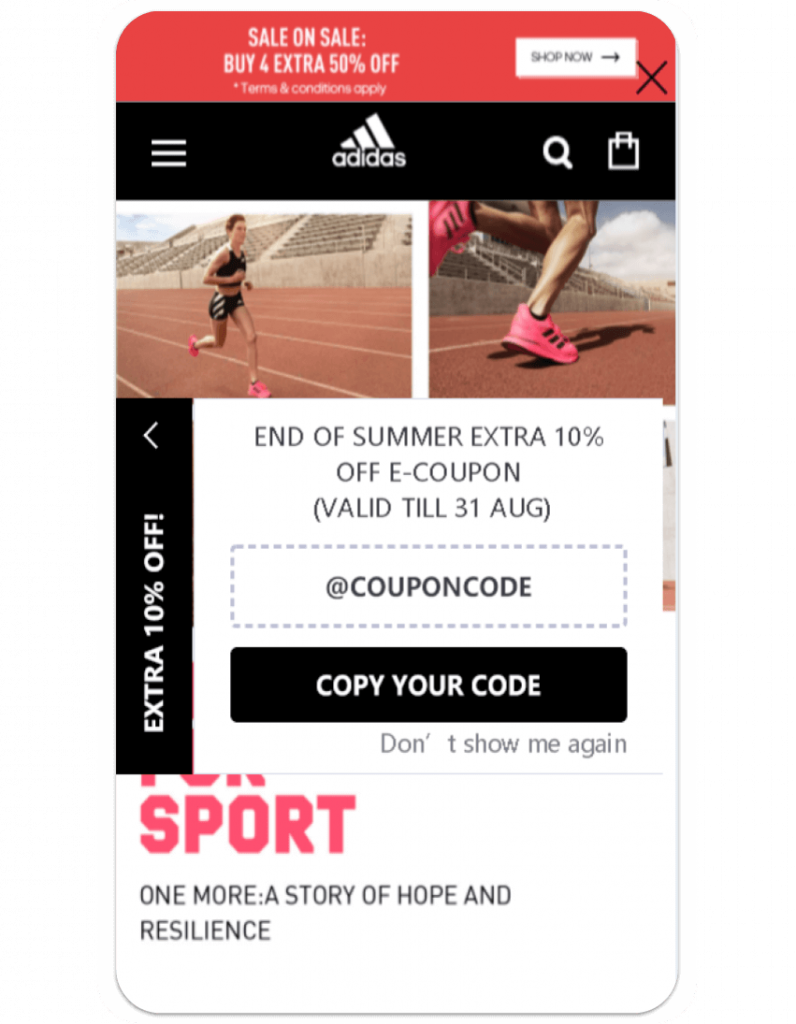
For instance, the use of Insider’s Web Suite enabled the creation of distinct coupon variations for different customer segments, resulting in a significant increase in AOV from new users and a notable rise in conversion rates for returning users.
Lastly, Adidas leveraged the Category Optimizer tool to optimize its mobile user experience, leading to a 50.3% increase in mobile conversion rates.
For a deeper dive into Adidas’ approach, check out the complete case study.
Facing challenges like cart abandonment and a need for more sign-ups, United Colors of Benetton turned to Insider’s AI-powered customer journey builder — Architect.
This tool enabled them to create personalized customer journeys for different use cases.
For example, to reduce cart abandonment, Benetton implemented a three-stage web push notification strategy. This approach involved targeting customers who left items in their cart with timely notifications about new arrivals, followed by personalized messages and if needed, a coupon code. This method achieved a 4.8% conversion rate, which was 7 times higher than the industry average.
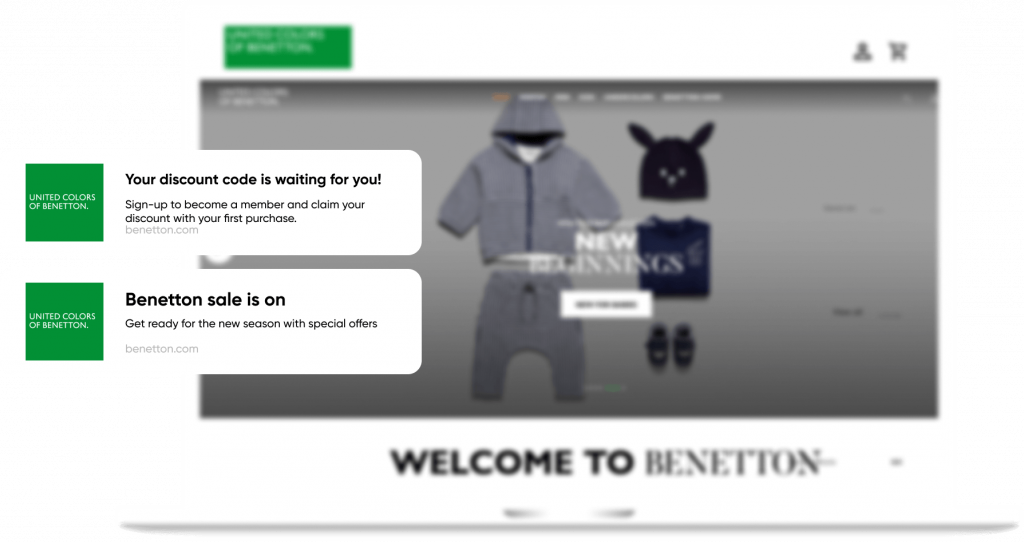
In terms of increasing new user sign-ups, Benetton crafted a web push journey flow, resulting in a 5.7% sign-up rate — a figure 10 times higher than the industry standard. These strategies, facilitated by predictive marketing, not only addressed Benetton’s initial challenges but also led to a substantial increase in their incremental revenue and user base.
Overall, Architect enabled the brand to create personalized customer journeys, leading to a 7x boost in conversions and a 10x increase in new customer acquisition. You can find the complete case study on our website.
When Pierre Cardin faced the challenge of escalating customer acquisition costs, they turned to Insider’s Predictive Ad Audiences (PAA). Using Insider’s AI-backed technology, Pierre Cardin was able to segment their audiences more effectively, focusing on user behaviors and predictive data. This approach allowed them to target customers who showed a real intent to purchase, leading to a significant optimization of their ad spend.
The results were remarkable. Pierre Cardin experienced a 445% uplift in conversion rates and a 164.83% increase in return on ad spend (ROAS).
Even more impactful was the reduction in their cost per acquisition (CPA), which dropped by 67.95%. By leveraging Insider’s expertise and predictive technology, Pierre Cardin not only achieved their goal of increasing ROAS but also greatly reduced their advertising costs, a result that was both surprising and highly beneficial for the brand.
You can learn more about how they utilized Insider’s predictive segmentation in the full case study.
Insider’s AI-powered intent engine, product recommendations, and journey orchestration capabilities help you accurately predict customer behaviors and tailor your marketing strategies to them.
You can use our enterprise marketing platform to:
Our vast template library lets you quickly take advantage of proven tactics, while our experienced support team can help you set up our platform, understand how it works, and implement the right marketing strategies for your needs.
Click here to schedule a demo and see how Insider can benefit your business.

Written by
Katie Morley
Katie is an award-winning content marketer with over eight years of experience in content strategy, development, and copywriting. As Global Content Director at Insider, she currently oversees content strategy across 26 regions. Fun fact: Katie read 64 books last year (for which she owes a long commute and two week-long holidays where she spent approximately six hours a day with her nose in a book).